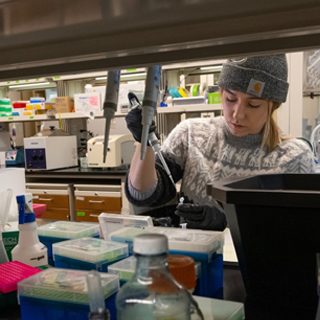Research Centers and Field Stations
-

Center for Biomolecular Structure and Dynamics
The mission of the Center is to foster biophysically informed research throughout the University of Montana (UM) research community. We do so by supporting core research facilities for macromolecular and small molecule X-ray crystallography, Nuclear Magnetic Resonance (NMR) spectroscopy, BioSpectroscopy, Mass Spectrometry, and Molecular Computation that provide the instruments and expertise in these biophysical methods to student and faculty researchers.
-

Center for Structural and Functional Neuroscience (CSFN)
The mission of the Center for Structural and Functional Neuroscience (CSFN) is to support and sustain a vibrant and collaborative environment that fosters multidisciplinary research and training aimed at advancing our understanding of the brain and diseases of the nervous system. The Center maintains a strong focus on basic neuroscience research at the chemical, biophysical, molecular, cellular levels, and supporting faculty and student researchers.
-

Center for Translational Medicine
The purpose of the Center for Translational Medicine at the University of Montana is to establish a cross-department and -college multi-disciplinary research center to assist faculty, staff and students in the translation of research ideas from bench to bedside. In this respect, translational research provides an avenue through which basic science discoveries in the biomedical sciences can be "translated" into applicable therapeutics, diagnostics, and/or processes that directly impact health care.
-

Montana Biotechnology Center (BIOTECH)
The Montana Biotechnology Center (BIOTECH) is focused on connecting students, entrepreneurs, scientists, and clinicians to enhance our local and regional biotechnology capabilities. The mission of BIOTECH is to enable local and regional biotechnology-focused workforce development through educational activities and research targeting the development of biomedical products, specifically therapeutics and medical devices, intended primarily for resource-limited settings such as the military in combat areas and/or rural settings. Additionally, we are targeting the development of physiologically representative in vitro models for biomedical research.
-

Montana Cooperative Wildlife Research Unit
The Wildlife Cooperative Research Unit is a unique collaborative relationship between States, Universities, the Federal government, and a non-profit organization. Coop Units conduct research on renewable natural resource questions, participate in the education of students, provide technical assistance and consultation to parties who have interests in natural resource issues, and provide various forms of continuing education for natural resource professionals.
-

Montana Institute on Ecosystems
The Montana Institute on Ecosystem’s mission is to facilitate, produce, assimilate, and share science-based knowledge, addressing both environmental and natural resources challenges, in partnership with stakeholders in Montana and beyond.
-

Neural Injury Center
The Neural Injury Center provides compassionate evidence-based assessments, conducts novel research, and delivers education to serve people with concussion/mTBI.
-

Flathead Lake Biological Station (FLBS)
Flathead Lake Biological Station is located at Yellow Bay, where FLBS faculty and staff work on environmental issues worldwide as well as on the Flathead River-Lake ecosystem. The FLBS Summer Field Ecology program, which serves both UM and visiting students, features hands-on courses embedded in Rocky Mountain biota, landscapes, and communities.
-

Field Research Station at Fort Missoula
The Field Research Station is a DBS research facility for physiological, functional and ecological research located a short drive from the main UM Campus in the historic district of Fort Missoula. It includes both research buildings and natural areas used for research, education and community outreach.
-

UM Natural Areas
The University of Montana has extensive natural areas available for research, education and recreation, including 500 acres on the face of the iconic Mount Sentinel and 100 acres on the banks of the Bitterroot River at Fort Missoula. These places are managed primarily for conservation of native plants and animals, but also receive heavy recreational use.
